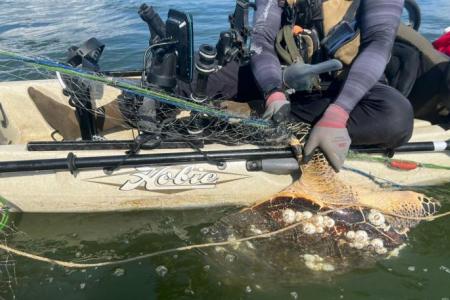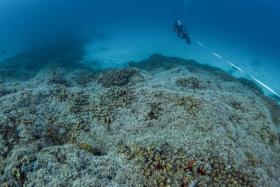Critically endangered hawksbill among two dead turtles found in S'pore waters
Kayak fishing tour guide Mohammad Nordin Kasmuri was on a fishing trip in the waters off Changi when one of his customers' lines got stuck in an "extremely heavy" net on Wednesday afternoon (March 16).
It took two people to haul up the 200m long gill net, the longest that he had seen, said the 36-year-old.
To their horror, a critically endangered hawksbill turtle, weighing more than 20kg, was ensnared in the net.
Immediately, he contacted marine conservation non-profit Marine Stewards, which alerted the authorities.
"I thought maybe it was alive so I cut the net as fast as I could to get its head up to the surface so it could breathe, that's when I noticed it was already dead," he told The Straits Times.
"There was no smell, no slime, it must have died very recently," Mr Nordin added.
The kayakers stayed on to hand the turtle to the Police Coast Guard, which passed the carcass to the National Parks Board (NParks) for checks.
Almost 24 hours later, Marine Stewards was alerted to another dead turtle found floating in the waters off Tuas.
How this turtle died is still unclear, said a Marine Stewards spokesman, noting that it was too badly decomposed.
The sustainable fishing group helps contact the authorities to rescue marine animals or pick up their carcasses when they receive requests from the public, she said.
The group has recorded four cases of turtles being trapped in gill nets in waters off Changi over the past year, she said.
Said the spokesman: "Nets and traps are an indiscriminate form of fishing with a low chance of survival for the creatures trapped in the net and they may end up drowning."
But it is still illegal for members of the public to remove active nets outside of protected areas. Only officials can disable and dispose of unattended nets.
Said Mr Nordin: "When our lines get stuck on these nets, we can only lift it up and remove our line.
"I've seen so many coral fishes that are not meant for consumption in these nets, they don't have a chance to survive but we are not allowed to remove the net."
He noted that the net which killed the dead turtle was likely to be active because there was no seaweed or marine growth.
A study of abandoned, lost, or discarded fishing gear at urban coastlines in Singapore published in February this year found that plastic polymer nets trapped the most number of creatures and the most number of species.
In order to reduce turtles getting stuck in nets, recreational fishermen can avoid leaving fishing gear unattended and remove abandoned lines as well as nets from marine areas, said marine biologist Zeehan Jafaar.
People can also chip in to help turtles by removing litter from shorelines and marine areas and minimising access to beaches during dark hours so these spaces can remain hospitable to nesting turtles, she added.
Should members of public encounter dead or live turtles, they should contact NParks at 1800-476-1600.
Data from turtle carcasses such as size, gender, condition of the carcass can be valuable records to understand the population of such animals in the area, said Dr Jafaar.
Get The New Paper on your phone with the free TNP app. Download from the Apple App Store or Google Play Store now


